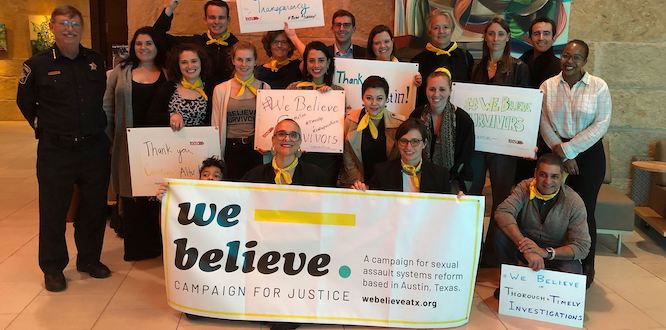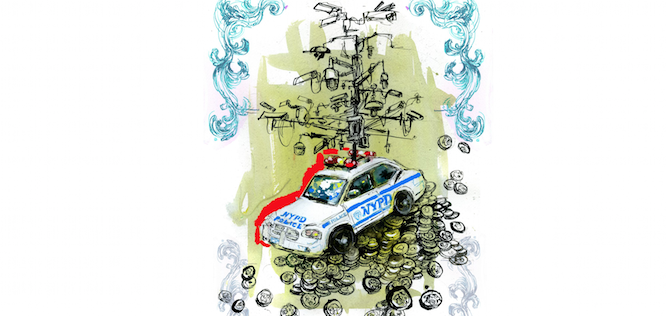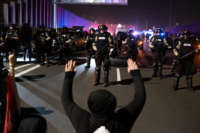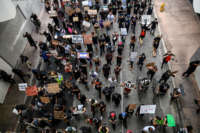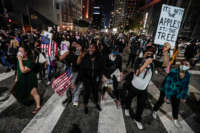
Woven into the municipal fabric of the U.S. is a little-known mechanism of privatization and corporate control: the Business Improvement District (BID). In hundreds of urban centers, invisible borders designate zones wherein local governments have granted control of the commons to private interests. Within the bounds of a BID, its corporate operators are empowered to contract for-profit companies to clean streets, make aesthetic and tourism upgrades and, more insidiously, enforce “security” in collaboration with police. In practice, this often results in the exclusion and harassment of populations that businesses find “undesirable” — anyone that is perceived as a threat to consumer activity and profit, and especially the unhoused.
BIDs are not unlike private governments; autonomous and often opaque, many operate free from meaningful oversight. From their financial structures to their influence on policy, they are typical of corporate privatization in that they divert public resources to serve the interests of the ownership class. The recent renewal of a multi-year BID contract in Portland, Oregon, rammed through against significant public opposition, was representative of the sort of unilateralism and impunity that characterizes BID operations. Analogous dynamics can be found across the United States, replicated within the over 1,200 BIDs nationwide.
The Imposition of BIDs
The BID model was first proposed in the 1970s by business interests in Toronto, Canada. Citing what they perceived as inadequate state maintenance services, they developed the concept to confer those powers upon themselves. BIDs have since proliferated, their mandate expanding to include security, marketing and political advocacy, including anti-homeless lobbying. They can wield considerable influence over local governments, often with the latter’s willing collaboration.
Paul Boden, executive director of the Western Regional Advocacy Project (WRAP), a homeless rights coalition, told Truthout, “Local governments across the country have decided that our neighborhoods, sidewalks, plazas and parks are theirs to negotiate away to business entities. [BIDs] are seeking to transform our neighborhoods to best suit the interests of the largest, overwhelmingly corporate property owners.”
Commercial areas in Portland are overlaid with a trio of BID zones, known locally as Enhanced Services Districts (ESDs). The largest of these, the innocuously titled Clean & Safe, was scheduled for a reassessment of its 10-year contract in September 2021. Sidestepping activist demands, public testimony and the recommendations of the city’s own auditors, Portland’s City Council pressed ahead, voting 4-1 to renew the contract for five years. To placate opponents, minor alterations were allowed: a cap on armed security guards, a mental health team and complaint reporting measures. Such marginal concessions did little to address deeper concerns about discriminatory policing and extractive financial structures. Councilor Jo Ann Hardesty, responsive to public outcry, remained the lone vote against.
The eagerness to renew the contract against all opposition and resident testimony is indicative of the sway of business interests over the council and Mayor Ted Wheeler — especially the leverage of the powerful Portland Business Alliance (PBA), the Chamber of Commerce equivalent that operates (and profits from) Clean & Safe. An auditor described the closely entwined PBA-Clean & Safe power structure as “a city within a city.”
Without the work of WRAP and allied organizers in Portland, the Clean & Safe contract renewal would have occurred behind closed doors, shielded from public input entirely. Activists successfully applied pressure to the city council to open the process to testimony. This testimony, along with an email campaign, resulted in the more sympathetic Councilor Hardesty introducing an amendment to delay the renewal. (It was voted down by the rest of the council.)
WRAP-organized protests, research and public awareness efforts around BIDs have been ongoing for years, surfacing invaluable information on their iniquitous practices and unaccountability. In fact, oversight of Portland’s BIDs was so wanting that without pressure from WRAP, a damning audit in August 2020 may never have been conducted — it was WRAP that first brought the iniquitous influence of the districts to the attention of the auditor’s office.
The End Clean & Safe coalition, comprising WRAP, the ACLU of Oregon, Stop the Sweeps PDX, Portland Jobs With Justice, the Portland Democratic Socialists of America, and numerous others, ran a campaign during the lead-up to the contract renewal to inform residents about the obscured realities of the structures in their city, urging them to testify in opposition. Activists also organized rallies against the renewal, among many other tireless efforts.
Among the WRAP activists who opposed the Clean & Safe contract is researcher Kaitlyn Dey. “This contract renewal is a testament to the egregious influence the Portland Business Alliance has over our city. And this isn’t unique to Portland,” Dey told Truthout. “BIDs have managed to grasp control of numerous city councils in order to maintain policing and lobbying activities that directly harm unhoused people.”
Private Cops, Public Spaces
A central critique of the BID model is its role in exacerbating the criminalization of the unhoused. In the United States, rife with economic austerity and housing insufficiency, a catastrophic homelessness crisis has been growing for decades. In response, the state has proven its readiness to resort to punishment and exclusion, repressing unhoused populations with measures like sit/lie ordinances, encampment sweeps and bans on panhandling, camping, vehicle dwelling and food sharing. BIDs encourage and capitalize on these practices, both by lobbying for anti-homeless legislation and through their own direct enforcement.
This is certainly the case in Portland. The city audit released in August 2020 confirmed what activists had long contended: Clean & Safe and the other BIDs intensify policing. According to auditors, their “enhanced law enforcement or criminal justice services create a risk of disparate outcomes compared to other parts of the city.” In 2017, over 50 percent of arrests by police in Portland were of the unhoused. Outside of BID boundaries, the average rate of arrest of unhoused people per square mile was 6.1. Within them, it was a staggering 137.7.
These dynamics are not exceptional, and are just as pernicious elsewhere. Portland, with a total of three, actually has comparatively few BIDs — New York City alone has 76, and California has 200 altogether. Roughly another thousand are strewn throughout the United States. A study of Californian BIDs conducted by the UC Berkeley School of Law concluded that “BID involvement in social services is experienced by homeless people as an additional form of policing, surveillance and harassment.” The report surveyed BIDs in 69 California cities and conducted in-depth case studies of the model in Berkeley, Chico, Los Angeles, Oakland, Sacramento, San Diego and San Francisco. Researchers found that more than 90 percent “coordinate closely with local police departments — and sometimes use their own private security — to enforce anti-homeless laws and otherwise exclude or remove homeless people from their districts.… Enforcement in California is growing and is increasingly based on homeless people’s status, rather than their behavior.”
Portland’s Clean & Safe fields both armed security guards and four Portland Police Bureau officers — public employees in the pay of private enterprise, a kind of mercenary activity that raises obvious conflicts of interest. The injustices and intrinsic biases of law enforcement are reinforced by the perverse incentives within BID borders that compel the exclusion of “undesirable” individuals at the behest of business.
Barbra Weber lived outdoors for a year and a half on Portland’s NW Davis St., where she experienced the enforcement arm of Clean & Safe firsthand. “What the police and Clean & Safe would do is they wouldn’t let anybody sleep…. Sleep deprivation is one tool they use. Sometimes they’ll just outright lie to you and tell you you’re on private property, or you’re bothering this business,” Weber told Truthout. “We went through this on a daily basis…. They’ll say they saw somebody using drugs or something, so they have a reason to call the police, and the police come and harass them.”
Weber says that Clean & Safe and police are directly responsive to requests from business owners. “They claim that we’re stopping their business from making money. I understand if there’s an incident, but these things are happening when there’s not an incident — somebody’s just sitting there.… They don’t even consider us human beings.”
Some BIDs extend their influence beyond the streets and into criminal legal systems. In Portland, it was found that BIDs were paying the salaries of dedicated assistant district attorneys and funding a community court in hopes of increasing enforcement. Further, some of those convicted by this BID-funded court were sentenced to community service for the BID’s own cleaning program, performing at least a million dollars’ worth of free labor: a complete circle of exploitation. A similar pattern was unveiled in St. Louis, Missouri. In Bogan v. Bonner, a state court ruled a community court unconstitutional, as the court and the presiding judge were in the direct pay of a local BID.
Structures of Profiteering
The problems with the BID model extend beyond their role in criminalization. The creation of a BID largely circumvents public input. They can be instituted by cities at the request of business or property interests, which, most commonly, petition the government to establish the zone and form a nonprofit to operate it.
As in the recent case of Portland, cities and business have overridden public opposition in creating or renewing the zones. In California, the decision to found a BID is put to a vote among affected property owners. However, in Los Angeles, among other cities, it is the largest owners that have a disproportionate say — votes scale with property value. In a BID vote in Los Angeles’s Chinatown, this weighting tipped the scales to keep a BID structure intact; the same occurred when the City used its weighted votes to push through a Venice Beach BID against majority opposition.
BID overseers collect fees from both private and public property owners in-district, “fund[ing] their activities partly with assessments on publicly owned buildings — in effect, using taxpayer money to achieve their goals,” noted the Berkeley report. This siphoning of public and private funds alike is facilitated by a legally binding assessment fee structure that is tantamount to private taxation.
Some who own properties in the district object to the levied fees, questioning the utility of improvement programs and aspects of their financing. One point of conflict over the Clean & Safe renewal centered on the fact that, as Willamette Week reported, Clean & Safe funds are channeled to the Portland Business Alliance, paying 45 percent of PBA staffing costs. These types of exploitative practices reflect a dearth of oversight and a fundamental accountability problem with the BID model.
Furthermore, BID income is commonly put toward lobbying in favor of criminalization ordinances. From the Berkeley report: California BIDs “advocate for anti-homeless policies … [using] property assessment revenue, including from public properties,” in violation of state law. The report also found a close correlation between the rising number of California BIDs and an increase in anti-homeless ordinances.
Examples abound: BIDs fervently supported sit/lie ordinances in San Francisco, while in Berkeley, a BID CEO was a major financial backer of another sit/lie law. To support a Chico, California anti-homeless ordinance, a BID coordinated with police and encouraged its members to attend and testify at city council meetings. A BID in Los Angeles advocated that the municipal code be amended “to preserve the city’s ability to confiscate homeless people’s property.” Relatedly, in 2017, the City of Los Angeles settled a lawsuit alleging that Los Angeles Police Department officers led BID contractors to confiscate the property of unhoused individuals, while threatening to arrest anyone who attempted to stop them. For their part, the California legislature has also been complicit: A 1994 law reduced oversight of BIDs and broadened their power to collect and spend revenue.
BIDs can be found lobbying against a payroll tax on big business in Seattle, or, in Denver, urging the city to pass a camping ban, then enforcing it. A BID in Washington, D.C. took over management of a public park and moved to expel unhoused people that had gathered there. California BIDs have also acted collectively, partnering together in a statewide alliance to oppose an act that would have limited anti-homeless laws in the state legislature. And, in a telling example, this coalition worked to defeat the passage of an unhoused bill of rights.
BIDs, of which the public is largely unaware, effectively grant private interests an arm of forcible social control, which they readily deploy to ward off perceived threats to the flow of profit. It’s true that they may contribute to city beautification and urban improvements, and some do at least attempt to connect unhoused people with services. But any fringe benefits of the model do not justify its exploitative architecture. It is not necessary to cede public spaces to private control, empowering business conglomerates to make decisions affecting the public square, in order to achieve the same ends.
BIDs worsen the discriminatory policing already ubiquitous in U.S. society and represent another conduit of the creeping privatization of public services. The result is that inequalities are reinscribed: The unhoused and underserved, the majority of them people of color, are immiserated, subjected to harassment and punishment and driven deeper into abjection. These structures represent another incarnation of the primacy of the profit motive over civil rights in the United States — and the unconscionable human toll that those imperatives exact.
Weber, reflecting on her experience with Portland’s BID police and security, said that their treatment was the source of “some of the roughest times I had to go through as a homeless person. You’re living on the streets, doing everything you can, you’re feeding each other and taking care of each other. And that’s offensive to them. Why?”
This post was originally published on Latest – Truthout.


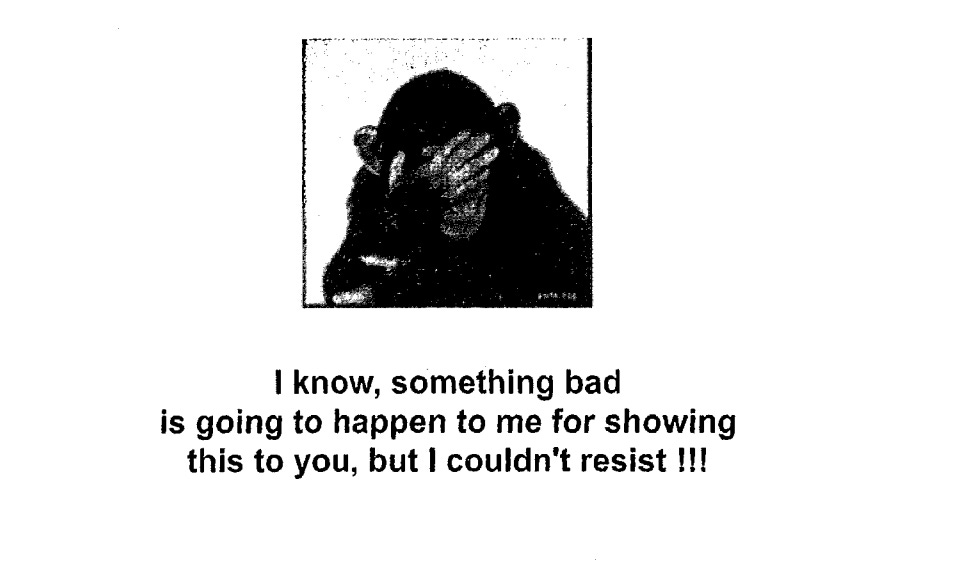









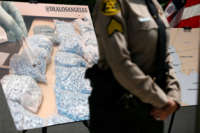

 #BlackLivesMatter (@AamerAnwar)
#BlackLivesMatter (@AamerAnwar) 
 A place that should safeguard him and enable him to learn and thrive. Police have no business being in schools.
A place that should safeguard him and enable him to learn and thrive. Police have no business being in schools. 

 #Black Lives Matter
#Black Lives Matter  #Windrush (@doloreselee)
#Windrush (@doloreselee) 
 (@VikCR_)
(@VikCR_) 
